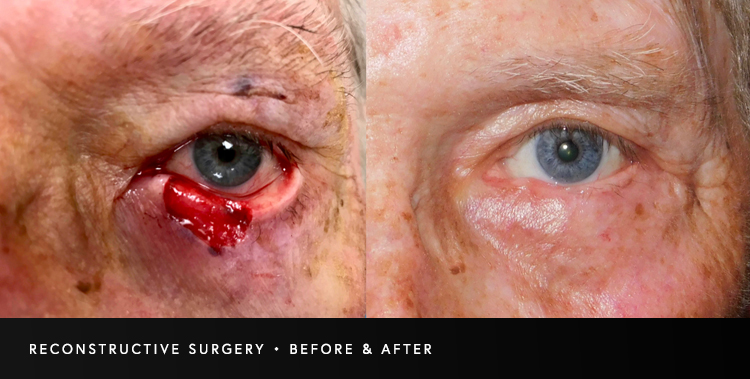Reconstructive Eye Surgery
Reconstructive oculofacial plastic surgery
Reconstructive oculofacial plastic surgery may be necessary following traumatic injuries, burns, and skin cancer removal (Mohs surgery), to restore both the function and appearance of the face and eyes.
When is oculoplastic reconstructive surgery indicated?
- Trauma: This can result from falls, motor vehicle accidents, assaults, animal bites, and work-related accidents. Reconstruction may involve repairing fractures, replacing lost tissue, and correcting scars.
- Cancer: After removal of skin cancer, patients are often left with an area of missing skin and soft tissue. Reconstructive surgery helps to close the defect and restore function and a more cosmetically acceptable appearance to the area.
- Burns: Severe burns can cause extensive scarring and disfigurement. Reconstructive surgery serves to restore function and improve appearance.
- Infection or Disease: Certain diseases and infections can cause significant tissue damage requiring reconstruction.
What are the reconstructive options?
Various methods can be used for reconstruction, including skin grafts and local or regional flaps. Depending on the size and location of the defect, different procedures may be used, including cartilage grafts, to restore the structure and shape of the face and eyelids.If the wound is small, Dr. Moore can often close the wound directly with sutures. For larger defects, tissue from an adjacent area may be moved to cover the wound leaving the blood supply intact. If the wound is larger, Dr. Moore might use skin from another part of the body (a skin graft) to cover the wound.
Facial fractures may need to be surgically repaired. Techniques used include rigid fixation, where small plates or screws are used to secure bones in their proper position.
In the case of eyelid lacerations or tissue loss, Dr. Moore may use grafts or flaps to reconstruct the eyelids. Both function and appearance are considered.
When the entire thickness of the eyelid is affected by skin cancer treatment, it will need surgical reconstruction to protect vision. The goal of eyelid reconstruction is twofold: to restore the protective function of the eyelids (they play a vital role in maintaining the health of the eyes) and to ensure a pleasing aesthetic outcome. This is typically a multi-stage process using a combination of skin grafts, flaps and even cartilage grafts for support.
Trauma can also damage the tear ducts leading to constant tearing. Dr. Moore may need to reconstruct the tear duct system, often with a stent that is left in place for a few months.
Additional cosmetic treatment may be needed
After surgery, patients may need additional treatments, depending on the extent of the trauma or the location of the skin cancer. They may also need additional cosmetic procedures to further improve appearance.
Schedule a consultation
It’s important to note that the exact procedures, risks, and outcomes can vary widely depending on the patient’s individual circumstances. Dr. Grant Moore is an experienced oculofacial plastic reconstructive surgeon. At your consult appointment, Dr. Moore will listen to your concerns and surgical goals. He will discuss all available options, including risks and benefits, and help you to determine a care plan that meets your needs and goals.
Scottsdale, Arizona surgeon, Dr. Grant Moore, is an oculofacial plastic surgeon who specializes in cosmetic and reconstructive surgery of the eyelids, eyebrows, face, and forehead. Oculofacial plastic surgeons have specialty training in ophthalmology and facial plastic and reconstructive surgery.
At a Glance
Grant Moore, MD
- Board Certified, Oculofacial Plastic Surgeon
- Over 5000 blepharoplasty surgeries performed
- Assistant Professor, University of Arizona-Phoenix
- Learn more


